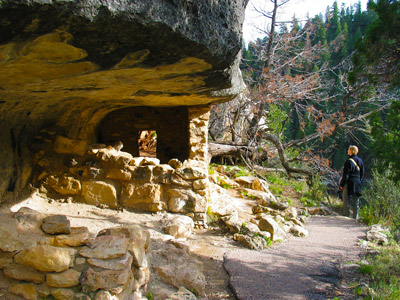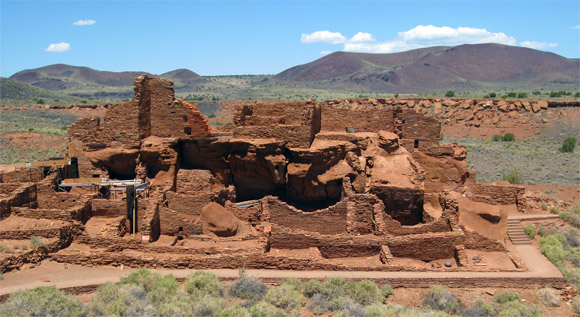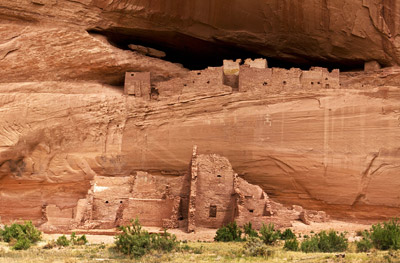
Ancient Indian Ruins & Cliff Dwellings
If you have a fascination with old ruins and ancient cultures, there is no better place in Arizona to base yourself than in the Sedona/Flagstaff area.
 Walnut Canyon Cliff Dwellings. Photo (cc) by ##http://commons.wikimedia.org/wiki/File:Walnut_canyon_cliff_dwellings.jpg#file##Daniel Schwen.
Walnut Canyon Cliff Dwellings. Photo (cc) by ##http://commons.wikimedia.org/wiki/File:Walnut_canyon_cliff_dwellings.jpg#file##Daniel Schwen.
Walnut Canyon National Monument
Located about 10 miles southeast of downtown Flagstaff, Walnut Canyon National Monument features a collection of single-story cliff dwellings built high on a canyon wall. The monument provides well preserved evidence of how the Sinagua Indians lived more than seven centuries ago. They constructed 300 rooms in the shelter of the canyon walls and thrived in the canyon for about 150 years. Their descendants now dwell together with the Hopi Indians in northeastern Arizona, whose first villages date from 1100 A.D.
The cliff dwellings nestled into the walls of beautiful Walnut Canyon provide a hands-on history lesson. Without a doubt, much of the fascination of Walnut Canyon is the chance to enter the dwellings, stepping into the past to experience an ancient way of life.
The Walnut Canyon National Monument is named after the Arizona walnut tree which was once widespread in the bottom of the canyon. The area is still an oasis for an abundant variety of creatures and plant life attracted to the water and the shelter provided by the landscape.
Visitors are able to explore and enjoy the park by hiking the Island Trail, which is a one-mile round trip. The path winds along the cliff near the dwellings for an up close view. The trail also allows great views down into the canyon where desert cacti thrive alongside mountain firs.
To reach Walnut Canyon from Flagstaff, travel east on Interstate 40 toward Albuquerque. Take Exit 204, and head south. The Walnut Canyon Visitor Center is located at the end of this 3 mile road.
Wupatki National Monument
Wupatki National Monument can be found about 33 miles northwest of Flagstaff, in the shadow of Arizona’s San Francisco Peaks. Once home to prehistoric Anasazi and Sinagua Indian farmers and traders — the Hisatsinom, as their Hopi descendants call them — you will discover scores of ruins scattered over a large section of desert. You can observe free-standing masonry pueblos, field houses, rock art, pottery, baskets and tools; remarkable signs of a diverse and complex way of life. The structures all have a distinctive deep red color and were built from thin, flat blocks of the regional Moenkopi sandstone. In all, over 2,700 archeological sites have been cataloged at Wupatki National Monument.
 This 700-year-old Wupatki Ruin contains nearly 100 rooms. Photo (cc) by ##http://www.flickr.com/photos/93452909@N00/3898467389/##Brew Books.
This 700-year-old Wupatki Ruin contains nearly 100 rooms. Photo (cc) by ##http://www.flickr.com/photos/93452909@N00/3898467389/##Brew Books.
The largest of the pueblos is Wupatki Ruin, in the southeastern portion of the monument. Here the Sinagua constructed an expansive three-story pueblo that contain nearly 100 rooms. They also built what is thought to be a ball court, which, although very different in design from the courts of the Aztec and Maya, indicates that a similar game was probably played in this area. Another circular stone structure just beneath the main ruins may have been an amphitheater or a dance plaza.
Five unique sites are accessible by car: Nalakihu, Citadel, Lomaki, Wupatki and Wukoki. Most of the ruins are in reasonably good condition and site visitors are permitted to study them freely. The monument provides several distinct trails for visitors to walk, hike, and view the different pueblos. Several rooms invite a closer inspection, an examination of the tiny windows, or the roof timber. The National Park Service provides plenty of parking and pathways to these five sites. At the south entrance, a Visitor Center offers literature and colorful information into the history of these ancient people.
Wupatki National Monument is located on the same road as Sunset Crater National Monument, and makes an excellent stop for anyone visiting Sunset Crater or the Grand Canyon – whose entrance is to the north of the Monument.
To reach Wupatki National Monument from Flagstaff, take US 89 north for 12 miles, turn right at sign for “Sunset Crater Volcano – Wupatki National Monuments.” The Visitor Center is 21 miles from this junction.
Canyon de Chelly National Monument
Approximately 3-1/2 hours from Flagstaff, tucked quietly away in the northeast corner of Arizona, is a place that inspires awe and introspection. Canyon de Chelly National Monument possesses sheer sandstone walls soaring up to 1,000 feet, numerous scenic overlooks, many well-preserved Anasazi ruins and an insight into the modern-day life of the Navajo, who still inhabit and cultivate the valley floor.
 This stunning photo was taken in 1904, over a century ago. Canyon de Chelly remains largely unchanged.
This stunning photo was taken in 1904, over a century ago. Canyon de Chelly remains largely unchanged.
Officially established on April 1, 1931 as a unit of the National Park Service, Canyon de Chelly (pronounced de SHAY) is situated inside the boundaries of the Navajo Nation. It preserves ruins of the early indigenous tribes that lived in the region, particularly the Ancient Pueblo Peoples (also called Anasazi) and Navajo. The monument covers 131 square miles and includes the floors and rims of three major canyons: de Chelly, del Muerto, and Monument. These canyons were carved by streams with headwaters in the Chuska mountains just to the east of the monument.
 The famous White House Ruins in Canyon de Chelly. Photo (cc) by ##http://commons.wikimedia.org/wiki/File:Canyon_de_Chelly_White_House.jpg#file##Cacophony.
The famous White House Ruins in Canyon de Chelly. Photo (cc) by ##http://commons.wikimedia.org/wiki/File:Canyon_de_Chelly_White_House.jpg#file##Cacophony.
The actual canyon floor stays green and fertile throughout the year; this, along with the shelter provided by the rocky walls and the splendor of the surroundings explain why the valley has been inhabited for so long — from primitive peoples 2000 years ago, through the Anasazi civilization of the 12th century, to the Navajo who have lived here for the past 300 years. This is also why Canyon de Chelly is deemed a living monument by the National Park Service. It is home to multiple Navajo families, who even now raise sheep and goats in the canyon, and grow crops.
Among the oldest Anasazi dwellings open to the public are the White House Ruins, a group of stone houses deep in the canyon at the bottom of a 500-foot cliff. These ruins were occupied from about 1060 to 1275 A.D. and are among the oldest existing dwellings to be found in North America.
Film lovers will recognize that Canyon de Chelly and the adjacent landscape have appeared as the backdrop for dozens of Hollywood films, including 1958’s The Big Country starring Charlton Heston and Gregory Peck.
Psychologist Carl Jung wrote that, with the exception of the Nile Valley, no place on earth more perfectly embodied the essence of antiquity than Canyon de Chelly. Folklore and religion scholar Joseph Campbell called the canyon, “the most sacred place on Earth.”
To reach Canyon de Chelly from Flagstaff, Arizona, take I-40 East then Hwy 191 North.

